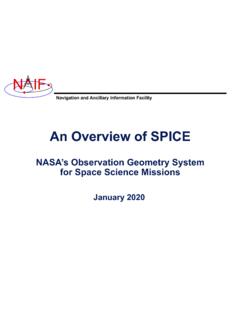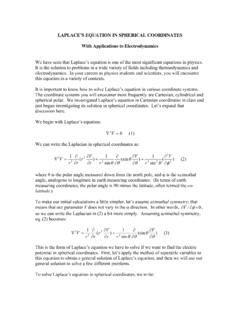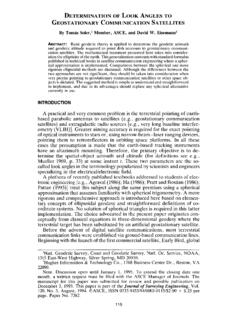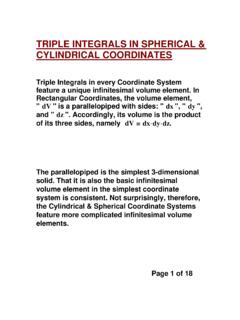Transcription of and Coordinate Systems - NASA
1 Navigation and Ancillary Information FacilityNIFAn Overview ofReference FramesandCoordinate Systemsin the SPICE ContextJanuary 2020 Navigation and Ancillary Information FacilityNIFP urpose of this Tutorial This tutorial provides an overviewof reference frames and Coordinate Systems . It contains conventions specific to SPICE. Details about the SPICE Frames Subsystem are found in other tutorials and one document: FK (tutorial) Using Frames (tutorial) Dynamic Frames (advanced tutorial) Frames Required Reading (technical reference) Details about SPICE Coordinate Systems are found in API module headers for Coordinate conversion and Coordinate Systems 2 Navigation and Ancillary Information FacilityNIFA Challenge Next to time, the topics of reference frames and Coordinate Systems present some of the largest challenges to documenting and understanding observation geometry. Contributing factors are .. differences in definitions, lack of concise definitions, and special cases evolution of the frames subsystem within SPICE the substantial frames management capabilities within SPICE NAIF hopes this tutorial will provide some clarity on these subjects within the SPICE context.
2 Definitions and terminology used herein may not be consistent with those found and Coordinate Systems 3 Navigation and Ancillary Information FacilityNIFF rames and Coordinate Systems The definitions below are used within SPICE. A reference frame(or simply frame ) is specified by an ordered set of three mutually orthogonal, possibly time dependent, unit-length direction vectors. A reference frame has an associated center. In some documentation external to SPICE, this is called a Coordinate frame. A Coordinate systemspecifies a mechanism for locating points within a reference frame. When producing or using state (position and velocity) or orientation (pointing) data, one needs to understand both the reference frame and the Coordinate system being Definitions4 Navigation and Ancillary Information FacilityNIFR eference FramesNavigation and Ancillary Information FacilityNIFR eference Frame Conventions All reference frames used within SPICE are right handed: this means X cross Y = ZFrames and Coordinate Systems XYZ6 Navigation and Ancillary Information FacilityNIFF rames and Coordinate Systems A reference frame s center must be a SPICE ephemeris object whose location is coincident with the origin (0, 0, 0) of the frame.
3 The center of any inertial frame is ALWAYS the solar system barycenter.* The center of a body-fixed frame is the center of the body. Body means a natural body: sun, planet, satellite, comet, asteroid. The location of the body center is specified using an SPK file. The center of a topocentric, spacecraft or instrument frame is also an object for which the location is specified by an SPK file. A frame s center may play a role in specification of states. The location of the origin cancels out when doing vector subtraction, but the center is used in computing light time to the center of any non-inertial frame being usedReference Frame Center*True even for inertial frames associated with accelerated bodies, such as the MARSIAU and Ancillary Information FacilityNIFF rames and Coordinate Systems Inertial Non-rotating with respect to stars Non-accelerating origin Velocity is typically non-zero, but acceleration is negligible Examples: J2000 (also known as EME 2000, and is actually ICRF) ECLIPJ2000 Types of Reference Frames -18 Navigation and Ancillary Information FacilityNIFF rames and Coordinate Systems Non-Inertial Accelerating, including by rotation Examples Body-fixed Associated with a natural body ( planets, satellites) Topocentric Associated with an object on or near the surface of a natural body ( DSN station, rover) Spacecraft Associated with the main spacecraft structure (the bus ) Instrument One or more frames are usually associated with each instrument Also applicable to a spacecraft antenna, solar array, etc.
4 Dynamic A special family of frames unique to SPICE These have time-dependent orientation But this category does notinclude frames for which the orientation is provided using a C-kernel (CK) or a PC-kernel (PCK)Types of Reference Frames -2CK spacecraft orientation; PCK natural body orientation9 Navigation and Ancillary Information FacilityNIFThe J2000 Inertial Frame The J2000* (aka EME2000) frame definition is based on the earth s equator and equinox, determined from observations of planetary motions, plus other Concepts10 Ecliptic planePlane defined by movement of the earth around the sunEquatorial planePlane normal to the earth s spin axis, ZIntersection ofequatorial and ecliptic planes,called vernalequinoxZJ2000XJ2000YJ2000~ degY = Z cross X*Caution: The name J2000 is also used to refer to the zero epoch of the ephemeris time system (ET, also known as TDB).Z is normal to the mean equator of date at epoch J2000 TDB, which is approximately Earth s spin axis orientation at that epoch.
5 (J2000 TDB is 2000 JAN 01 12:00:00 TDB, or JD TDB).Navigation and Ancillary Information FacilityNIFThe ICRF Inertial Frame The ICRF* frame is defined by the adopted locations of 295 extragalactic radio and Coordinate Systems XYZS olar System BarycenterICRF = International Celestial Reference FrameThe ICRF is managed by the International Earth Rotation Service (IERS)11 Navigation and Ancillary Information FacilityNIFJ2000 versus ICRF The realization of ICRF was made to coincide almost exactly with the J2000 frame. The difference is very small a rotation of less than arc second. These two frames are considered the same in SPICE. In reality, any SPICE data said to be referenced to the J2000 frame are actually referenced to the ICRF frame. For historical and backwards compatibility reasons, only the name J2000 is recognized by SPICE software as a frame name not ICRF. No transformation is required to convert SPICE state vectors or orientation data from the J2000 frame to the and Coordinate Systems 12 Navigation and Ancillary Information FacilityNIFF rames and Coordinate Systems Body-fixed frames are tied to a named body and rotate with it Specifications for the most common body-fixed frames, those for the sun, the planets, many satellites, and a few asteroids and comets, are hard-coded in SPICE software Frame name style is IAU_bodyname Examples: IAU_MARS, IAU_SATURN To see all such names, see: Frames Required Reading document, or Latest generic PCK file The rotation state (the orientation at time ) is usually determined using a SPICE text PCK containing data published by the IAU The earth and moon are special cases!
6 IAU_EARTH and IAU_MOON both exist but generally should NOT be used See the SPICE tutorial named lunar-earth_pck-fk for the best frames to be used for those bodies On very rare occasions a CK is used to provide a body s rotation stateBody-fixed FramesZYX Body-fixed 13 Navigation and Ancillary Information FacilityNIFA Caution for Mars The body-fixed frame for Mars is named IAU_MARS This follows the SPICE naming standard for such frames However, there also exists in SPICE an inertial frame associated with Mars, named MARSIAU This frame was defined 20 years ago based on old Mars rotation constants, for use by the Mars Observer and Mars Global Surveyor projects This frame has NO relationship to the similarly sounding IAU_MARS frame, other than that they both relate to MarsFrames and Coordinate Systems 14 Navigation and Ancillary Information FacilityNIFF rames and Coordinate Systems Defined for spacecraft, and items attached to a spacecraft, such as antennas, solar arrays, scan platforms, instruments and moving parts of an instrument ( a scanning mirror) For those frames that are time varying ( moving ), the frame name is usually defined in an FK and the frame orientation data are usually provided by a CK For those frames that are not moving (what we call fixed offset ) both the frame name and the actual data defining the fixed orientation of the frame are provided in an FKSpacecraft and Instrument Frames15 Navigation and Ancillary Information FacilityNIFSome Examples ofSpacecraft and Instrument FramesSolar array gimbal position relative to spacecraft center ( structures SPK file)Camera frameorientation relative to spacecraft frame ( mission FK file)Spacecraft frameorientation relative to inertial frame ( spacecraft CK file)Spacecraft position relative to planet center ( spacecraft SPK file)High gain antenna gimbal position relative to spacecraft( structures SPK file)
7 Solar array gimbal frameorientation relative to spacecraft frame ( solar array CK file)Magnetometer position relative to solar array gimbal ( structures SPK file)Magnetometer frameorientation relative to solar array gimbal frame( mission FK file)High gain antenna gimbal frameorientation relative to spacecraft frame( antenna CK file)High gain antenna phase center location relative to high gain antenna gimbal ( structures SPK file)High gain antenna frame orientation relative to high gain antenna gimbal frame( mission FK file)XMYMZMZCXCYCZAXAYAZAGXAGYAGZSGYSGXS GZSCYSCXSCP osition VectorsFrame OrientationsFrames and Coordinate Systems 16 Navigation and Ancillary Information FacilityNIFF rames and Coordinate Systems Topocentric frames are located at or near to a body's surface One axis is normal to a reference spheroid, or parallel to the gravity gradient* Examples: frames defined for telecommunications stations, or for landers or roversX points NorthTopocentric FramesY points WestZ points up The graphic illustrates one example of a topocentric frame.
8 There is nota standard definition for example, the z-axis could point down, the x-axis North, and the y-axis East. *SPICE tools always have the up or down axis being normal to the spheroid. But one could use external data to determine the local gravity gradient and construct a frame based on and Ancillary Information FacilityNIFF rames and Coordinate Systems 18 Dynamic Frames In a dynamic frame the orientation changes with time Families: Two-vector, Euler, and Of-date (refer to Dynamic Frames tutorial) This category excludes frames for which the orientation is determined by a PCK or CK Example of a two-vector dynamic frame: Geocentric Solar Ecliptic (GSE) X = earth sun vector Y = component of the sun s velocity perpendicular to X Z = X cross YEcliptic PlaneVsun relative to earthXY = component ofVsun perpendicular to XYZN avigation and Ancillary Information FacilityNIFC oordinate SystemsNavigation and Ancillary Information FacilityNIFF rames and Coordinate Systems A Coordinate system specifies the method used to locate a point within a particular reference Coordinate SystemsRectangular or Cartesian coordinates :X, Y, ZSpherical coordinates .
9 , , Two examples of Coordinate Systems used to locate point P 20 Navigation and Ancillary Information FacilityNIFS pecifying PositionsCommon StyleSPICE StyleCenter Point ofinterest Target is an Ephemeris Object Observer is an Ephemeris Object Center is anEphemeris ObjectFrames and Coordinate Systems 21 Navigation and Ancillary Information FacilityNIFMany Coordinate Systems Used In the Planetary Science discipline there are a number of Coordinate Systems in use, just as there are quite a few reference frames in use. Some of these Coordinate Systems have well accepted standard definitions, while others are anything but standard. This means data producers and especially data users need to pay close attention to what they are doing!Frames and Coordinate Systems 22 Navigation and Ancillary Information FacilityNIFF rames and Coordinate Systems PlanetocentricCoordinate System For planets and their satellites the +Z axis (+90 latitude) always points to the north side of the invariable plane (the plane whose normal vector is the angular momentum vector of the solar system) Planetocentric longitude increases positively eastward (-180 to +180) Planetocentric latitude increases positively northward (-90 to +90) Dwarf planets*, asteroids and comets spin in the right hand sense about their positive pole.
10 What the IAU now calls the positive pole is still referred to as the north pole in SPICE documentation. The positive pole may point above or below the invariable plane of the solar system (see above). This revision by the IAU Working Group (2006) inverts what had been the direction of the north pole for Pluto, Charon and Ida. Toolkit planetocentric APIs: LATREC, RECLAT, DRDLAT, DLATDR, XFMSTA*The dwarf planets are: Ceres, Eris, Haumea, Makemake, PlutoXYZP23 Navigation and Ancillary Information FacilityNIFF rames and Coordinate Systems PlanetodeticCoordinate System Planetodetic longitude is the same as planetocentric longitude Increases positively eastward (-180 to +180) Planetodetic latitude Tied to a reference ellipsoid For a point, P, on a reference ellipsoid, the angle measured from the X-Y plane to the surface normal at the point of interest. For points not on the ellipsoid, equals latitude at the nearest point on the reference ellipsoid Increases positively northward (-90 to +90) Toolkit planetodetic APIs are: GEOREC, RECGEO, DRDGEO, DGEODR, XFMSTAXYZP24 Navigation and Ancillary Information FacilityNIFF rames and Coordinate Systems PlanetographicCoordinate System For planet and satellite planetographic Coordinate Systems : Planetographic longitude is usually defined such that the sub-observer longitude increases with time as seen by a distant, fixed observer (0 to 360) The earth, moon and sun are exceptions; planetographic longitude is positive east by default (0 to 360) Planetographic latitude is planetodetic latitude (-90 to +90) Toolkit planetographic APIs are: PGRREC, RECPGR, DRDPGR, DPGRDR, XFMSTA For dwarf planets, asteroids and comets: There are multiple, inconsistent standards!











